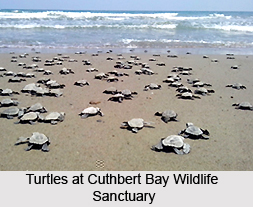 Cuthbert Bay Wildlife Sanctuary is situated at the coast of the Middle Andaman Islands of the Indian union territory Andaman and Nicobar Islands comprising about 8 kilometres of the sandy beach. It stretches to a distance of 600 metres inside the land beginning from the high tide mark along the coast. Around the sanctuary a calm village life wrapped in enchanting tranquillity can be enjoyed. The place exhibits virgin natural beauty with fresh breeze. Cuthbert Bay Wildlife Sanctuary is also considered as a nestling ground of turtles. The sanctuary covers an area of 5.82 square kilometres.
Cuthbert Bay Wildlife Sanctuary is situated at the coast of the Middle Andaman Islands of the Indian union territory Andaman and Nicobar Islands comprising about 8 kilometres of the sandy beach. It stretches to a distance of 600 metres inside the land beginning from the high tide mark along the coast. Around the sanctuary a calm village life wrapped in enchanting tranquillity can be enjoyed. The place exhibits virgin natural beauty with fresh breeze. Cuthbert Bay Wildlife Sanctuary is also considered as a nestling ground of turtles. The sanctuary covers an area of 5.82 square kilometres.
Flora of Cuthbert Bay Wildlife Sanctuary
The coastal vegetation of Cuthbert Bay Wildlife Sanctuary has an abundance of Ipmea species. Tall Casuarina trees dot the region making the place scenic and pleasant. All the major species of mangroves that grows in the Andaman Islands are found in the sanctuary. Semi-evergreen and deciduous forests cover the region. The commercially valuable species of the sanctuary which are endemic to this region include Gurjan, Thipok and Padauk.
Fauna of Cuthbert Bay Wildlife Sanctuary
Turtles are the major attractions of this sanctuary which come to the beach, dig pits and lay eggs there before returning to the sea. This activity can be observed during the night time. During the season, the turtles can be seen coming to the beach every night. The procedure of the transfer of eggs to the hatchery can also be witnessed by the tourists. Tourists can also enjoy the releasing of the turtle hatchlings in the sea, contributing in the marine turtle conservation efforts. Common species found here include Leatherback Turtle, Hawksbill Turtle, Green Sea Turtles and Olive Ridley Turtle. Turtle nesting can be seen from November to March.
Spotted Deer is an important member of Cuthbert Bay Wildlife Sanctuary which was introduced here by the British Government. The forest near the coast, the beach and the mangroves shelter a number of Spotted Deer. The sanctuary also shows a rich diversity of avifauna which can be easily spotted on the beach. Common birds which dwell here enlist Curlews, Lesser Whistling Ducks, Pond Herons, Stork billed Kingfisher etc. Endemic butterfly of the sanctuary is known as Andaman Mormon which is frequently seen here. Salt Water Crocodile is also found here. Water Monitor Lizards and Terrestrial Lizards can be spotted along the beach. Terrestrial and water snakes also constitute the fauna of the region.
Visiting Information
Cuthbert Bay Wildlife Sanctuary is best visited between the months of October and April. It is located at a distance of 196 kilometres from Port Blair. A nature walk along the coastal zone is extremely pleasing for the tourists. Eco huts are also provided for the rest and accommodation of the tourists.











